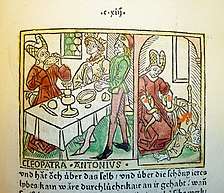Death of Cleopatra
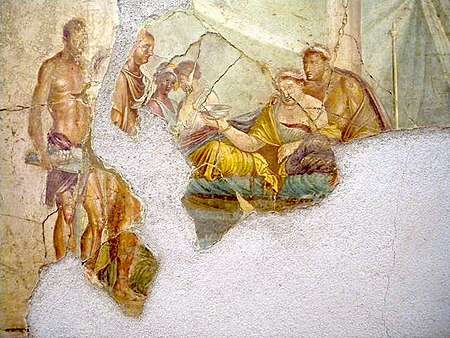
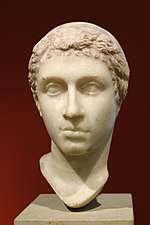 |
| Part of a series on |
| Cleopatra VII |
|---|
The death of Cleopatra VII, the last reigning ruler of Ptolemaic Egypt, occurred on either 10 or 12 August 30 BC in Alexandria, when she was 39 years old. According to a popular belief, Cleopatra committed suicide by allowing an asp (Egyptian cobra) to bite her. In other versions offered by Roman historians, Cleopatra poisoned herself using either an implement or toxic ointment. Primary source accounts are derived mainly from the works of the ancient Roman historians Strabo, Plutarch, and Cassius Dio. Some modern scholars speculate that she was murdered, while others doubt the validity of the accounts involving snakebites as the cause of death. Some academics hypothesize that her Roman rival Octavian, out of political expediency, allowed Cleopatra to commit suicide in the manner of her choosing.
Cleopatra's death effectively ended the final war of the Roman Republic between Octavian and Mark Antony, in which Cleopatra aligned herself with Antony, her husband and father to three of her children. Antony and Cleopatra fled to Egypt following their loss at the 31 BC Battle of Actium in Roman Greece, after which Octavian invaded Egypt and defeated their forces. The location of Cleopatra's tomb is unknown, although it was recorded that Octavian allowed for her and Antony, who committed suicide by stabbing, to be buried together properly. Cleopatra's death marked the end of the Hellenistic period and Ptolemaic rule of Egypt, as well as the beginning of Roman Egypt, which became a province of the Roman Empire.[note 1] By committing suicide, she avoided the humiliation of being paraded as a prisoner in a Roman triumph celebrating the military victories of Octavian, who would become Rome's first emperor and known as Augustus. Octavian had her son Caesarion, rival heir of Julius Caesar, killed in Egypt but spared her other children and brought them to Rome.
The death of Cleopatra has been depicted in various works of art in ancient, medieval, early modern, and modern times. These include the visual, literary, and performing arts, ranging from sculptures and paintings to poetry and plays, as well as modern films. Cleopatra featured prominently in the prose and poetry of ancient Latin literature. While surviving ancient Roman depictions of her death in visual arts are rare, Medieval, Renaissance, Baroque, and Modern works are numerous. Ancient Greco-Roman sculptures such as the Esquiline Venus and Sleeping Ariadne served as inspirations for later artworks portraying her death, universally involving the snakebite of an asp. Cleopatra's death has also involved themes of eroticism and sexuality, in works that include paintings, plays, and films, especially from the Victorian era. Modern works depicting Cleopatra's death range from Neoclassical sculpture to Orientalist painting, the latter of which has influenced other mediums such as cinema.
Precise dating
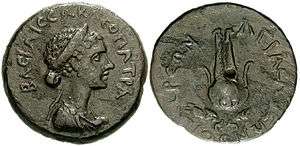
The exact date of Cleopatra's death was unknown for a long time, since there is no surviving record of even the approximate date.[3] Theodore Cressy Skeat deduced that her death occurred on 12 August 30 BC on the basis of contemporary records of fixed events.[3] His dating is supported by Stanley M. Burstein,[4] James Grout,[5] and Aidan Dodson and Dyan Hitlon, although the latter are more tepid by stating it was circa 12 August.[6] The alternative dating of 10 August 30 BC is supported by scholars such as Duane W. Roller,[7] Joann Fletcher,[8] and Jaynie Anderson.[9]
Prelude
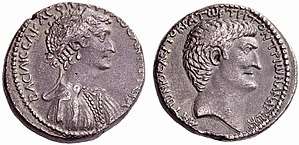
Following their defeat in the naval Battle of Actium at the Ambracian Gulf of Greece in 31 BC, Cleopatra VII of Ptolemaic Egypt and her Roman husband Mark Antony retreated back to Egypt to recuperate and prepare for an assault by Octavian, whose forces grew larger with the surrender of many of Antony's officers and soldiers in Greece.[10][11][12][note 2] After a long period of failed negotiations, Octavian's forces invaded Egypt in the spring of 30 BC.[13][14] While Octavian captured Pelousion near the eastern borders of Ptolemaic Egypt, his officer Cornelius Gallus marched from Cyrene and captured Paraitonion to the west.[15][16] Although Antony was able to score a small victory over Octavian's tired troops as they approached Alexandria's hippodrome on 1 August 30 BC, Antony's naval fleet and cavalry defected to Octavian soon afterwards.[15][12][17]
Suicide of Mark Antony and Cleopatra
With Octavian's forces now in Alexandria, Cleopatra withdrew to her tomb with her closest attendants and had a message sent to Antony that she had committed suicide.[15][20][21] Antony ordered his slave Eros to kill him, but Eros used his sword to commit suicide instead.[20][21] In despair, Antony stabbed himself through the stomach with a sword, dying at age 53.[15][12][4] In historian Plutarch's version of events, Antony was still alive as he was carried into the tomb of Cleopatra, telling her in his dying words that he would die honorably and that she could trust a certain Gaius Proculeius on Octavian's side to treat her well.[15][22][23] It was this same Proculeius who used a ladder to breach a window of Cleopatra's tomb and detain her inside before she could have a chance to commit suicide or burn herself to death along with her vast treasure.[15][24] Cleopatra was permitted to embalm the body of Antony before she was forcefully escorted to the palace and eventually met with Octavian, who had also detained three of her children: Alexander Helios, Cleopatra Selene II, and Ptolemy Philadelphus.[25][4][26]
As related by Livy, in her meeting with Octavian, Cleopatra told him candidly, "I will not be led in a triumph" (Ancient Greek: οὑ θριαμβεύσομαι, translit. ou thriambéusomai), but Octavian only gave her a cryptic answer that her life would be spared.[27][28] He did not offer her any specific details about his plans for Egypt or her royal family.[29] When a spy informed Cleopatra that Octavian intended to bring her back to Rome to be paraded as a prisoner in his Roman triumph, she decided to avoid this humiliation and take her own life at age 39, in August 30 BC.[12][7][30][note 3] Plutarch elaborates how Cleopatra approached her suicide in an almost ritual process, preceded by bathing and then a fine meal including figs brought to her in a basket.[31][9][32]
Plutarch reports that Octavian ordered his freedman Epaphroditus to guard her and prevent her from committing suicide.[33] However, Cleopatra was able to deceive Epaphroditus and kill herself nevertheless.[33] When Octavian received a note from Cleopatra requesting that she be buried next to Antony, he had his messengers rush to her and break down her door, but they were too late.[31] Plutarch states that she was found dead, her handmaiden Iras dying at her feet, and handmaiden Charmion adjusting Cleopatra's diademed crown before she herself fell.[31][34][35][note 4] It is unclear from primary sources if their suicides took place within the palace or inside Cleopatra's tomb.[7] Cassius Dio claims that Octavian quickly called on trained snake charmers of the Psylli tribe of Ancient Libya to attempt an oral venom extraction and revival of Cleopatra, but their efforts failed.[5][36] Although Octavian was outraged by these events and "was robbed of the full splendor of his victory" according to Cassius Dio,[36] he had Cleopatra interred next to Antony in their tomb as requested, and also gave Iras and Charmion proper burials.[31][37][32]
Cause of death

Cleopatra's personal physician Olympos, cited by Plutarch, failed to mention any cause of death for his queen and made no report about an asp bite or Egyptian cobra.[41][note 5] Strabo, who provides the earliest known historical account, believed that Cleopatra committed suicide either by asp bite or poisonous ointment.[9][42][43][note 6] Plutarch mentions the tale of the asp brought to her in a basket of figs, although he offers other alternatives for her cause of death, such as use of a hollow implement (Greek: κνηστίς, translit. knestis), perhaps a hairpin,[32] which she used to scratch open the skin and introduce the toxin.[41] According to Cassius Dio, although small punctures on Cleopatra's arm were found, he echoed the claim by Plutarch that nobody knew the true cause of her death.[44][41][5] Dio mentioned the claim of the asp and even suggested use of a needle (Greek: βελὁνη, translit. belone), possibly from a hairpin, which would seem to corroborate with Plutarch's account.[44][41][5] Other historians such as Florus and Velleius Paterculus supported the asp bite version.[45][46] Roman physician Galen mentioned the asp story,[46] but he also narrated a version where Cleopatra bit her arm and introduced venom there brought to her in a container.[47] Suetonius relayed the story of the asp but expressed doubt about it.[46]
Modern scholars have also cast doubt on the story of the venomous snakebite as the cause of death. Duane W. Roller notes the prominence of snakes in Egyptian mythology while also asserting that no surviving historical account discusses the difficulty of smuggling a large Egyptian cobra into Cleopatra's chambers and then having it behave as intended.[41] William Maloney concurs with this assessment, noting the incredible weight of these reptiles, but states that their venom is very powerful,[48] whereas Roller claims the venom is only fatal if injected into a vital area of the body.[41] The German Egyptologist Wilhelm Spiegelberg (1870–1930) argued that Cleopatra's choice of suicide by asp bite was one that befitted her royal status, with the asp representing the uraeus, sacred serpent of the ancient Egyptian sun god Ra.[49] However, Robert A. Gurval points out that the Athenian strategos Demetrios of Phaleron (c. 350 – c. 280 BC), confined by Ptolemy II Philadelphus in Egypt, committed suicide by asp bite in a "curiously similar" manner, one that also demonstrated that it was not exclusive to Egyptian royalty.[50] Gurval notes that the bite of an Egyptian cobra contains around 175–300 mg of neurotoxin, lethal to humans with only 15–20 mg, although death would not have been immediate as victims usually stay alive for several hours.[51]
According to Gregory Tsoucalas and Markos Sgantzos, evidence suggests that Octavian ordered the poisoning of Cleopatra.[52] Their claim of alleged murder by Octavian is supported by other authors such as Maloney.[53] In her Murder of Cleopatra: History's Greatest Cold Case (2013), the criminal profiler Pat Brown argues that Cleopatra was murdered and the details of it were covered up by Roman authorities.[54] Claims that she was murdered, however, contradict the majority of primary sources that report her cause of death as suicide.[55] Patricia Southern speculates that Octavian could have possibly allowed Cleopatra to choose the manner of her death instead of executing her.[20] James Grout writes that Octavian may have wanted to avoid the sort of sympathy espoused for Cleopatra's younger sister Arsinoe IV when she was paraded in chains but spared during Julius Caesar's triumph.[5] Realizing the political problems of killing a queen whose statue had been erected by his adoptive father Caesar in the Temple of Venus Genetrix, Octavian perhaps permitted Cleopatra "to die by her own hand," according to Grout.[5]
Aftermath
.jpg)
In her last moments of life, Cleopatra attempted to have Caesarion, her co-ruler and son with Julius Caesar, sent away to Upper Egypt and perhaps eventually to Nubia, Ethiopia, or India.[46][58][16] However, Caesarion would reign as Ptolemy XV for only eighteen days, when he was captured and executed by Octavian's orders on the 29 August 30 BC, at the advice of the philosopher Arius Didymus.[59][60] His death and that of Cleopatra's marked the end of the Ptolemaic dynasty's rule of Egypt as well as the Hellenistic period,[note 1] as Egypt became a province of the newly-established Roman Empire, with Octavian renamed in 27 BC as Augustus, the first Roman emperor.[61][62][63][note 7] However, Roller affirms that Caesarion's alleged reign was "essentially a fiction" invented by chroniclers of Egypt such as Clement of Alexandria (in his Stromata), in order to explain the gap between Cleopatra's death and the induction of Egypt as a Roman province directly ruled by Octavian as pharaoh of Egypt.[64][note 8] Antony's three children with Cleopatra were spared and sent to Rome, their daughter Cleopatra Selene II eventually marrying Juba II of Mauretania.[26][65][66]
Cleopatra's tomb
The site of the mausoleum of Cleopatra and Mark Antony is uncertain.[26] However, the Egyptian Antiquities Service believes that it is in or near a temple of Taposiris Magna, southwest of Alexandria.[67][68] In their excavations of the temple of Osiris at Taposiris Magna, Dominican archaeologist Kathleen Martinez and Egyptian archaeologist Zahi Hawass have discovered six burial chambers along with various artifacts, including forty coins minted by Cleopatra and Antony as well as an alabaster bust depicting Cleopatra.[69] British Egyptologist John Baines argues that a bronze statue of Aphrodite—a foreign goddess to the Egyptians—found at the site indicates a uniquely "Ptolemaic connection", but classicist Mary Beard has expressed doubt about Taposiris Magna being the location of Cleopatra or Antony's tomb.[70] In an early-1st-century AD painting from the House of Giuseppe II in Pompeii, a rear wall depicted with a set of double doors positioned very high above the scene of a woman wearing a royal diadem and committing suicide among her attendants suggests the described layout of Cleopatra's tomb in Alexandria.[1]
Depictions in art and literature
Hellenistic and Roman eras
.jpg)
In his triumphal procession at Rome in 29 BC, Octavian paraded Cleopatra's children Alexander Helios and Cleopatra Selene II, but he also presented an effigy to the crowd depicting Cleopatra with an asp clinging to her.[73][9][74] This was likely the same painting discovered in emperor Hadrian's Villa in 1818, now lost but described in an archaeological report and depicted in a steel engraving by John Sartain.[38][39] However, the poet Propertius, an eyewitness of Octavian's triumph along the Via Sacra, noted that the paraded image of Cleopatra contained multiple snakes biting each of her arms.[51][75] Citing Plutarch, Giuseppe Pucci indicates that the effigy may have even been a statue.[76] In his "Notes isiaques I" (1989), French Archaeologist Jean-Claude Grenier observed that an ancient Roman statue of a woman wearing a knot of Isis in the Vatican Museums portrays a snake crawling up her right breast, perhaps a depiction of Cleopatra's suicide while dressed as the Egyptian goddess Isis.[77]
A mid-1st-century BC Roman wall painting from Pompeii most likely depicting Cleopatra with her infant son Caesarion was walled off by its owner around 30 BC, perhaps in reaction to Octavian's proscription against images depicting Caesarion, the rival heir of Julius Caesar.[56][57] Although statues of Mark Antony were torn down, those of Cleopatra were generally spared this program of destruction, including the one erected by Caesar in the Temple of Venus Genetrix in the Forum of Caesar.[78][79] An early-1st-century AD painting from Pompeii most likely depicts the suicide of Cleopatra, accompanied by attendants and even her son Caesarion wearing a royal diadem like his mother, although an asp is absent from the scene, perhaps reflecting the different causes of death provided in Roman historiography.[80][2][note 10]
The story of the asp was widely accepted among the Augustan-period Latin poets such as Horace and Virgil, in which two snakes were even suggested as biting Cleopatra.[81][9][82] Although retaining the negative views of Cleopatra apparent in other pro-Augustan Roman literature,[83] Horace depicted Cleopatra's suicide as a bold act of defiance and liberation.[84] Virgil established the view of Cleopatra as a figure of epic melodrama and romance.[85]
Medieval, Renaissance, and Baroque periods
The story of Cleopatra's suicide by snakebite was often depicted in Medieval and Renaissance art, as well as Medieval and Renaissance literature. In a miniature of a 1409 AD illuminated manuscript of the 14th-century AD poet Giovanni Boccaccio's Des cas de nobles hommes et femmes, the Boucicaut Master depicted Cleopatra and Antony lying together in a Gothic-style tomb, with a snake near Cleopatra's chest and a bloody sword through that of Antony's.[88] Illustrated versions of Boccaccio's written works, including images of Cleopatra and Antony committing suicide, first appeared in France during the Quattrocento (i.e. 15th century AD), authored by Laurent de Premierfait.[89] Woodcut illustrations of Boccaccio's De Mulieribus Claris published at Ulm in 1479 and Augsburg in 1541 depict Cleopatra's discovery of Antony's body after his suicide.[90]
Boccaccio provided largely negative and misogynistic views about Cleopatra in his writings, which were countered by 14th-century poet Geoffrey Chaucer, who offered a more positive view of Cleopatra.[91] Chaucer began his hagiography on virtuous pagan women with the life of Cleopatra, depicted in a satirical fashion as a queen engaged in courtly love with her knight Mark Antony.[92][93] However, Chaucer's depiction of her suicide included a pit of serpents rather than the Roman tale of the asps.[94][95]
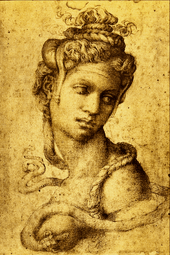
During the Italian Renaissance, free-standing nude depictions of Cleopatra being bitten by the asp became common.[96] The 16th-century Venetian artist Giovanni Maria Padovano (i.e. Mosca) created two marble reliefs of the suicide of Antony and Cleopatra, as well as various free-standing nude statues of Cleopatra being bitten by the asp that were partly inspired by ancient Roman sculptures such as the Esquiline Venus.[97][note 11] Bartolommeo Bandinelli created a drawing of Cleopatra as a free-standing nude committing suicide that served as the basis for a similar engraving by Agostino Veneziano.[96] Another engraving by Veneziano and a drawing by Raphael depicting Cleopatra's suicide as she slumbered were inspired by the ancient Greco-Roman Sleeping Ariadne, which at the time was thought to depict Cleopatra.[98][99] Works of the French Renaissance also depict Cleopatra slumbering while pressing a snake to her breast.[100] Michelangelo created a black-chalk drawing of Cleopatra's suicide by asp bite around 1535.[101] The 17th-century Baroque painter Guido Reni depicted Cleopatra's death by asp bite, although the snake depicted is tiny compared to a real Egyptian cobra.[102]
The Sleeping Ariadne, acquired by Pope Julius II in 1512, inspired the composition of three poems that were eventually carved into the pilaster frame of the statue.[103] The first of these poems was published by Baldassare Castiglione, which became widely circulated by 1530 and inspired the other two by Bernardino Baldi and Agostino Favoriti.[75] Castiglione's poem depicted Cleopatra as a tragic but honorable ruler in a doomed love affair with Antony, a queen whose death freed her from the ignominy of Roman imprisonment.[104] The Sleeping Ariadne was also commonly depicted in paintings, including those by Titian, Artemisia Gentileschi, and Edward Burne-Jones.[99] These works tended to eroticize the moment of Cleopatra's death, while Victorian era artists found the unconscious, recumbent female form as an acceptable outlet for their eroticism.[99]
Cleopatra's death is featured in various works of the performing arts. In the 1607 play Devil's Charter by Barnabe Barnes, a snake handler brings the two asps to Cleopatra and allows them to bite both her breasts in a racy manner.[101] In William Shakespeare's 1609 play Antony and Cleopatra the snake represents both death as well as a lover who Cleopatra desires, yielding to his pinch.[101] Shakespeare relied on Thomas North's 1579 translation of Plutarch for crafting his play, which can be viewed as both a comedy and a tragedy.[105] The play involved use of multiple asps, as well as the character of Charmion who killed herself by asp bite after Cleopatra.[106]
Modern era
In modern literature, Ted Hughes' poem "Cleopatra to the Asp" (1960) creates a monologue of Cleopatra speaking to the asp that is about to kill her.[108] During the Victorian era, plays such as Cléopâtre (1890) by Victorien Sardou became popular, although audiences were generally shocked by the emotional intensity of stage actress Sarah Bernhardt's depiction of Cleopatra reacting to Antony's suicide.[109] In opera, Samuel Barber's Antony and Cleopatra, first performed in 1966 and based on Shakespeare's play, Cleopatra recounts a dream that Antony, now dead before her, would become emperor of Rome.[110] When Dollabella informs her that Caesar intends to march her in his triumph in Rome, she commits suicide with Charmion by asp bite, before being carried off to be buried with Antony.[111]
In cinema, the character of Cleopatra had appeared in forty-three different films by the end of the 20th century.[112] Georges Méliès' Robbing Cleopatra's Tomb (French: Cléopâtre), an 1899 French silent horror film, was the first film to depict the character of Cleopatra.[113] Following the Italo-Turkish War (1911–1912), the 1913 Italian film Marcantonio e Cleopatra by Enrico Guazzoni depicted Cleopatra as the embodiment of the cruel Orient, a queen who had defied Rome, while the actions of her lover Antony, after his suicide, are forgiven by Octavian.[114] In cultivating a stage persona for her character in the US film Cleopatra (1917), actress Theda Bara was seen in public petting snakes while the Fox Film Corporation posed her in front of Cleopatra's alleged mummified remains in a museum, where she announced that she was the reincarnation of Cleopatra, having received hieroglyphic tributary offerings from a reincarnated servant.[115] Fox Studios also had Bara dress as a leader of the occult and associated her with perverse death and sexuality.[115] The 1963 Hollywood film Cleopatra by Joseph L. Mankiewicz contains a dramatic scene where the Egyptian queen, portrayed by Elizabeth Taylor, is engaged in a slap-fight with her lover Mark Antony, portrayed by Richard Burton, inside the tomb where they would be interred.[116]
In other modern visual arts, Cleopatra has been depicted in mediums such as paintings and sculptures. In her 1876 sculpture The Death of Cleopatra, African-American artist Edmonia Lewis, despite championing the non-white female form in artworks, chose to depict Cleopatra with Caucasian features, perhaps in keeping with Cleopatra's recorded lineage as a Macedonian Greek.[107][note 12] Lewis' Neoclassical sculpture offers a post-mortem view of Cleopatra dressed in Egyptian regalia and sitting on her throne, which is decorated with two sphinx heads that represent the twins she bore with Mark Antony: Alexander Helios and Cleopatra Selene II.[117] An 1880 plaster sculpture of Cleopatra committing suicide, now found in Lille, France, was once thought to be a work by Albert Darcq, but a restoration and cleaning of the sculpture revealed the signature of Charles Gauthier, to whom the work is now attributed.[118] The 1874 painting Death of Cleopatra by Jean-André Rixens depicts a dead Cleopatra with very light skin, accompanied by maidservants with rather dark skin, a combination frequently found in modern artworks portraying the scene of Cleopatra's death.[119] Orientalist paintings by Rixens and others influenced the hybrid Ancient-Egyptian and Middle-Eastern decor found in the J. Gordon Edwards' film Cleopatra starring Bara, seen standing on a Persian carpet but with Egyptian wall paintings in the background.[120]
Paintings
- The Death of Cleopatra, by Michele Tosini, c. 1560
 Cleopatra, by Guido Reni, 1638-1639[102]
Cleopatra, by Guido Reni, 1638-1639[102] The Death of Cleopatra, by Alessandro Turchi, c. 1640
The Death of Cleopatra, by Alessandro Turchi, c. 1640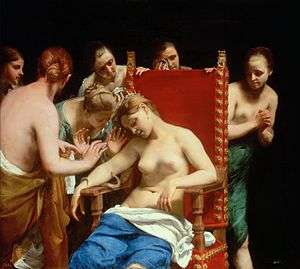 The Death of Cleopatra by Guido Cagnacci, 1658
The Death of Cleopatra by Guido Cagnacci, 1658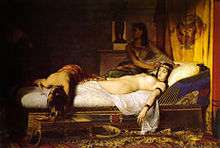 The Death of Cleopatra by Jean-André Rixens, 1874[5]
The Death of Cleopatra by Jean-André Rixens, 1874[5]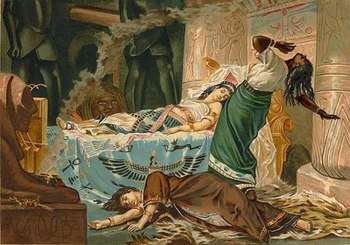 The Death of Cleopatra by Juan Luna, 1881.
The Death of Cleopatra by Juan Luna, 1881.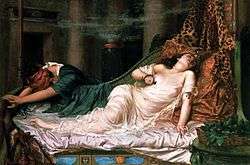 The Death of Cleopatra by Reginald Arthur, 1892
The Death of Cleopatra by Reginald Arthur, 1892
Engravings
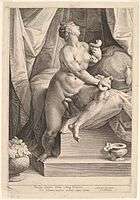 Cleopatra, by Jan Muller, after Adriaen de Vries, c. 1598
Cleopatra, by Jan Muller, after Adriaen de Vries, c. 1598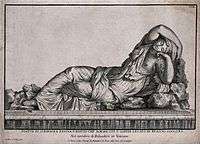 The suicide of Cleopatra: the asp is wriggling up the left arm of the sleeping Cleopatra (after the Sleeping Ariadne), engraving by Jean-Baptiste de Poilly (1669-1728)
The suicide of Cleopatra: the asp is wriggling up the left arm of the sleeping Cleopatra (after the Sleeping Ariadne), engraving by Jean-Baptiste de Poilly (1669-1728)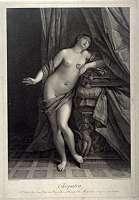 Cleopatra, by Robert Strange (after Guido Reni), 1777
Cleopatra, by Robert Strange (after Guido Reni), 1777
Statues, busts and other sculptures
 The Esquiline Venus, 1st-century AD Roman copy of a late Hellenistic artwork from the 1st century BC, with a snake depicted on the vase at the base and a woman wearing a royal diadem[56]
The Esquiline Venus, 1st-century AD Roman copy of a late Hellenistic artwork from the 1st century BC, with a snake depicted on the vase at the base and a woman wearing a royal diadem[56]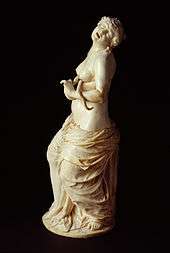 Cleopatra taking her own life with the bite of a venomous serpent, Adam Lenckhardt (1610-1661), Ivory, the Walters Art Museum[121]
Cleopatra taking her own life with the bite of a venomous serpent, Adam Lenckhardt (1610-1661), Ivory, the Walters Art Museum[121] Bust of Cleopatra committing suicide, by Claude Bertin (d. 1705)
Bust of Cleopatra committing suicide, by Claude Bertin (d. 1705)- Cleopatra, by Charles Gauthier, 1880
See also
- Amanirenas (contemporary queen of Kush who fought a war against the Romans in Egypt and Nubia)
- Ancient Egypt in the Western imagination
- Assassination of Julius Caesar
- Death of Alexander the Great
- Early life of Cleopatra
- List of cultural depictions of Cleopatra
- Reign of Cleopatra
References
Notes
- 1 2 Grant 1972, pp. 5–6 notes that the Hellenistic period, beginning with the reign of Alexander the Great (336–323 BC), came to an end with the death of Cleopatra in 30 BC. Michael Grant stresses that the Hellenistic Greeks were viewed by contemporary Romans as having declined and diminished in greatness since the age of Classical Greece, an attitude that has continued even into the works of modern historiography. In regards to Hellenistic Egypt, Grant argues that "Cleopatra VII, looking back upon all that her ancestors had done during that time, was not likely to make the same mistake. But she and her contemporaries of the first century BC had another, peculiar, problem of their own. Could the 'Hellenistic Age' (which we ourselves often regard as coming to an end in about her time) still be said to exist at all, could any Greek age, now that the Romans were the dominant power? This was a question never far from Cleopatra's mind. But it is quite certain that she considered the Greek epoch to be by no means finished, and intended to do everything in her power to ensure its perpetuation."
- ↑ For further validation, see Southern 2009, pp. 149–150 and Grout 2017.
- ↑ For further validation, see Jones 2006, p. 180 and Grout 2017.
- ↑ For primary source translations of Plutarch's account of the deaths of Charmion and Iras, see Plutarch 1920, p. 85, Grout 2017, and Jones 2006, pp. 193–194.
- ↑ Historian Duane W. Roller, in Roller 2010, pp. 148–149, provides a thorough explanation of the various claims about Cleopatra's cause of death in Roman historiography and primary sources. He states unequivocally that Olympos did not describe any cause of death, only that Plutarch discussed the cause of death only after he was finished relaying the report by Olympos, introducing the tale of the asp bite in such a way that he expected his readers to have already had foreknowledge about it. Maloney 2010, p. 3, on the other hand, seems to conflate Plutarch's musings about the cause of death with Olympos' official report, claiming that Olympos "theorized" about Cleopatra's cause of death as being caused by an asp bite or toxic ointment.
- ↑ For further validation, see Roller 2010, p. 148.
- ↑ For further validation, see Jones 2006, pp. 197–198.
- ↑ For further information, see Skeat 1953, pp. 99–100.
Plutarch, translated by Jones 2006, p. 187, wrote in vague terms that "Octavian had Caesarion killed later, after Cleopatra's death."
Contrary to regular Roman provinces, Octavian established Egypt as territory under his personal control, barring the Roman Senate from intervening in any of its affairs and appointing his own equestrian governors of Egypt, the first of whom was Cornelius Gallus. For further information, see Southern 2014, p. 185 and Roller 2010, p. 151. - ↑ Fletcher 2008, p. 87 describes the painting from Herculaneum further: "Cleopatra's hair was maintained by her highly skilled hairdresser Eiras. Although rather artificial looking wigs set in the traditional tripartite style of long straight hair would have been required for her appearances before her Egyptian subjects, a more practical option for general day-to-day wear was the no-nonsense 'melon hairdo' in which her natural hair was drawn back in sections resembling the lines on a melon and then pinned up in a bun at the back of the head. A trademark style of Arsinoe II and Berenike II, the style had fallen from fashion for almost two centuries until revived by Cleopatra; yet as both traditionalist and innovator, she wore her version without her predecessor's fine head veil. And whereas they had both been blonde like Alexander, Cleopatra may well have been a redhead, judging from the portrait of a flame-haired woman wearing the royal diadem surrounded by Egyptian motifs which has been identified as Cleopatra."
- ↑ For further information about the painting in the House of Giuseppe II (i.e. Joseph II) at Pompeii and the possible identification of Cleopatra as one of the figures, see Pucci 2011, pp. 206–207, footnote 27
- ↑ As outlined by Pina Polo 2013, pp. 186, 194 footnote10, Roller 2010, p. 175, Anderson 2003, p. 59, scholars debate whether or not the Esquiline Venus—discovered in 1874 on the Esquiline Hill in Rome and housed in the Palazzo dei Conservatori of the Capitoline Museums—is a depiction of Cleopatra, based on the hairstyle and facial features of the woman in the sculpture, her apparent royal diadem worn over the head, and the uraeus Egyptian cobra wrapped around a vase or column at the base. As explained by Roller 2010, p. 175, the Esquiline Venus is generally thought to be a mid-1st-century AD Roman copy of a 1st-century BC Greek original from the school of Pasiteles.
- ↑ Pucci 2011, p. 201 affirms that "to give Cleopatra a white complexion is quite correct, given her Macedonian descent. In literature, however, Cleopatra's racial features are more ambiguous."
For Cleopatra's European origins through her ancestor Ptolemy I Soter of Macedonia in northern Greece, see Fletcher 2008, pp. 1, 23.
Citations
- 1 2 Roller (2010), pp. 178–179.
- 1 2 Elia (1955), pp. 3–7.
- 1 2 Skeat (1953), pp. 98–100.
- 1 2 3 Burstein (2004), p. 31.
- 1 2 3 4 5 6 7 Grout (2017).
- ↑ Dodson & Hilton (2004), p. 277.
- 1 2 3 Roller (2010), pp. 147–148.
- ↑ Fletcher (2008), p. 3.
- 1 2 3 4 5 Anderson (2003), p. 56.
- ↑ Roller (2010), p. 140.
- ↑ Burstein (2004), pp. xxii–xxiii, 30–31.
- 1 2 3 4 Bringmann (2007), p. 304.
- ↑ Burstein (2004), pp. xxiii, 31.
- ↑ Roller (2010), pp. 144–145.
- 1 2 3 4 5 6 Roller (2010), p. 145.
- 1 2 Southern (2009), p. 153.
- ↑ Southern (2009), pp. 153–154.
- ↑ Pina Polo (2013), pp. 184–186.
- ↑ Roller (2010), pp. 54, 174–175.
- 1 2 3 Southern (2009), p. 154.
- 1 2 Jones (2006), p. 184.
- ↑ Southern (2009), pp. 154–155.
- ↑ Jones (2006), pp. 184–185.
- ↑ Jones (2006), pp. 185–186.
- ↑ Roller (2010), p. 146.
- 1 2 3 Southern (2009), p. 155.
- ↑ Roller (2010), pp. 146–147, 213 footnote83.
- ↑ Gurval (2011), p. 61.
- ↑ Roller (2010), pp. 146–147.
- ↑ Burstein (2004), pp. xxiii, 31–32.
- 1 2 3 4 Roller (2010), p. 147.
- 1 2 3 Jones (2006), p. 194.
- 1 2 Plutarch (1920), p. 79.
- ↑ Anderson (2003), p. 56, 62.
- ↑ Gurval (2011), pp. 72.
- 1 2 Jones (2006), p. 195.
- ↑ Burstein (2004), p. 65.
- 1 2 Pratt & Fizel (1949), pp. 14–15.
- 1 2 Sartain (1885), pp. 41, 44.
- ↑ Plutarch (1920), p. 54.
- 1 2 3 4 5 6 Roller (2010), p. 148.
- ↑ Jones (2006), p. 197.
- ↑ Gurval (2011), p. 55.
- 1 2 Jones (2006), pp. 194–195.
- ↑ Jones (2006), pp. 189–190.
- 1 2 3 4 Roller (2010), p. 149.
- ↑ Jones (2006), pp. 195–197.
- ↑ Maloney (2010), p. 3.
- ↑ Gurval (2011), p. 56.
- ↑ Gurval (2011), p. 58.
- 1 2 Gurval (2011), p. 60.
- ↑ Tsoucalas & Sgantzos (2014), pp. 19–20.
- ↑ Maloney (2010), pp. 3–4.
- ↑ Nuwer (2013).
- ↑ Jones (2006), pp. 180–201.
- 1 2 3 Roller (2010), p. 175.
- 1 2 Walker (2008), pp. 35, 42–44.
- ↑ Burstein (2004), p. 32.
- ↑ Roller (2010), pp. 149–150.
- ↑ Burstein (2004), pp. xxiii, 32.
- ↑ Burstein (2004), pp. xxiii, 1.
- ↑ Bringmann (2007), pp. 304–307.
- ↑ Roller (2010), pp. 150–151.
- ↑ Roller (2010), p. 149, 151, 214, footnote 103.
- ↑ Burstein (2004), p. 32, 76–77.
- ↑ Roller (2010), pp. 153–155.
- ↑ BBC News.
- ↑ SBS News.
- ↑ Remezcla.
- ↑ National Geographic News.
- ↑ Walker & Higgs (2001), pp. 314–315.
- ↑ Fletcher (2008), pp. 87, 246–247, see image plates and captions.
- ↑ Roller (2010), pp. 149, 153.
- ↑ Burstein (2004), p. 66.
- 1 2 Curran (2011), p. 116.
- ↑ Pucci (2011), p. 202.
- ↑ Pucci (2011), pp. 202–203, 207 footnote 28.
- ↑ Roller (2010), p. 72, 151, 175.
- ↑ Varner (2004), p. 20.
- ↑ Roller (2010), pp. 148–149, 178–179.
- ↑ Roller (2010), pp. 148–149.
- ↑ Gurval (2011), pp. 61–69, 74.
- ↑ Roller (2010), pp. 8–9.
- ↑ Gurval (2011), pp. 65–66.
- ↑ Gurval (2011), pp. 66–70.
- ↑ Anderson (2003), pp. 53-54.
- ↑ Anderson (2003), p. 50.
- ↑ Anderson (2003), pp. 53–54.
- ↑ Anderson (2003), p. 51.
- ↑ Anderson (2003), pp. 50–52.
- ↑ Anderson (2003), pp. 51–54.
- ↑ Gurval (2011), pp. 73–74.
- ↑ Jones (2006), pp. 214–215.
- ↑ Gurval (2011), p. 74.
- ↑ Jones (2006), pp. 221–222.
- 1 2 Anderson (2003), p. 60.
- ↑ Anderson (2003), pp. 56–59.
- ↑ Anderson (2003), pp. 60–61.
- 1 2 3 Pucci (2011), p. 203.
- ↑ Anderson (2003), p. 61.
- 1 2 3 Anderson (2003), p. 62.
- 1 2 Gurval (2011), p. 59.
- ↑ Curran (2011), p. 114-116.
- ↑ Curran (2011), pp. 116–117.
- ↑ Jones (2006), p. 223.
- ↑ Jones (2006), pp. 233–234.
- 1 2 Pucci (2011), pp. 201–202.
- ↑ Jones (2006), pp. 303–304.
- ↑ DeMaria Smith (2011), p. 165.
- ↑ Martin (2014), pp. 16–17.
- ↑ Martin (2014), p. 17.
- ↑ Pucci (2011), p. 195.
- ↑ Jones (2006), pp. 325.
- ↑ Pucci (2011), pp. 203–204.
- 1 2 Wyke & Montserrat (2011), p. 178.
- ↑ Wyke & Montserrat (2011), p. 190.
- ↑ Smithsonian American Art Museum.
- ↑ The Art Tribune.
- ↑ Manninen (2015), p. 221, footnote 11.
- ↑ Sully (2010), p. 53.
- ↑ Walters Art Museum.
Cited in text
Online sources
- "Cleopatra's tomb may have been found: Egypt's top archaeologist says the lost tomb of Mark Antony and Cleopatra may have been discovered". SBS News. 24 February 2015. Retrieved 20 May 2018.
- "Dig 'may reveal' Cleopatra's tomb". BBC News. 15 April 2009. Retrieved 24 April 2009.
- Cleopatra, The Walters Art Museum, retrieved 29 March 2018.
- "Inside a Dominican Archaeologist's Drama-Filled Quest to Find Cleopatra's Tomb". Remezcla.com. 24 April 2017. Retrieved 22 May 2018.
- Restorations of 19th century sculptures in Lille, The Art Tribune, 11 February 2016, retrieved 3 May 2018.
- The Death of Cleopatra, Smithsonian American Art Museum, retrieved 3 May 2018.
- Grout, James (1 April 2017), The Death of Cleopatra, Encyclopaedia Romana (University of Chicago), retrieved 3 May 2018.
- Maloney, William J. (2010), "The Death Of Cleopatra, A Medical Analysis Of The Theory Of Suicide By Naja Haje" (PDF), Toxicology, 1 (8), doi:10.9754/journal.wmc.2010.00502, retrieved 8 May 2017.
- Milstein, Mati (30 May 2008). "Cleopatra Bust Among Treasures Found in Egypt Temple". National Geographic News. Retrieved 22 May 2018.
- Nuwer, Rachel (29 March 2013), Maybe Cleopatra Didn’t Commit Suicide: Her murder, one author thinks, was covered up behind a veil of propaganda and lies put forth by the Roman Empire, Smithsonian, retrieved 3 May 2018.
- Plutarch (1920), Plutarch's Lives, translated by Bernadotte Perrin, Cambridge, MA: Harvard University Press (Perseus Digital Library, Tufts University), retrieved 29 March 2018.
Printed sources
- Anderson, Jaynie (2003), Tiepolo's Cleopatra, Melbourne: Macmillan, ISBN 9781876832445.
- Bringmann, Klaus (2007) [2002], A History of the Roman Republic, translated by W. J. Smyth, Cambridge: Polity Press, ISBN 9780745633718.
- Burstein, Stanley M. (2004), The Reign of Cleopatra, Westport, CT: Greenwood Press, ISBN 9780313325274.
- Curran, Brian A (2011), "Love, Triumph, Tragedy: Cleopatra and Egypt in High Renaissance Rome", in Miles, Margaret M., Cleopatra : a sphinx revisited, Berkeley: University of California Press, pp. 96–131, ISBN 9780520243675.
- DeMaria Smith, Margaret Mary (2011), "HRH Cleopatra: the Last of the Ptolemies and the Egyptian Paintings of Sir Lawrence Alma-Tadema", in Miles, Margaret M., Cleopatra : a sphinx revisited, Berkeley: University of California Press, pp. 150–171, ISBN 9780520243675.
- Dodson, Aidan; Hilton, Dyan (2004), The Complete Royal Families of Ancient Egypt, London: Thames & Hudson, ISBN 9780500051283.
- Elia, Olga (1955), "La tradizione della morte di Cleopatra nella pittura pompeiana", Rendiconti dell’Accademia di archeologia, lettere e belle arti (in Italian), 30: 3–7.
- Fletcher, Joann (2008), Cleopatra the Great: The Woman Behind the Legend, New York: Harper, ISBN 9780060585587.
- Grant, Michael (1972), Cleopatra, London: Weidenfeld and Nicolson; Richard Clay (the Chaucer Press), ISBN 9780297995029.
- Gurval, Robert A. (2011), "Dying Like a Queen: the Story of Cleopatra and the Asp(s) in Antiquity", in Miles, Margaret M., Cleopatra : a sphinx revisited, Berkeley: University of California Press, pp. 54–77, ISBN 9780520243675.
- Jones, Prudence J. (2006), Cleopatra: a sourcebook, Norman, Oklahoma: University of Oklahoma Press, ISBN 9780806137414.
- Manninen, Alisa (2015), Royal Power and Authority in Shakespeare's Late Tragedies, Newcastle Upon Tyne: Cambridge Scholars Publishing, ISBN 9781443876223.
- Martin, Nicholas Ivor (2014), The Opera Manual, Lanham, Maryland: Scarecrow Press, ISBN 9780810888685.
- Pina Polo, Francisco (2013), "The Great Seducer: Cleopatra, Queen and Sex Symbol", in Knippschild, Silke; García Morcillo, Marta, Seduction and Power: Antiquity in the Visual and Performing Arts, London: Bloomsbury Academic, pp. 183–197, ISBN 9781441190659.
- Pratt, Frances; Fizel, Becca (1949), Encaustic Materials and Methods, New York: Lear, OCLC 560769.
- Pucci, Giuseppe (2011), "Every Man's Cleopatra", in Miles, Margaret M., Cleopatra : a sphinx revisited, Berkeley: University of California Press, pp. 195–207, ISBN 9780520243675.
- Roller, Duane W. (2010), Cleopatra: a biography, Oxford: Oxford University Press, ISBN 9780195365535.
- Sartain, John (1885), On the Antique Painting in Encaustic of Cleopatra: Discovered in 1818, Philadelphia: George Gebbie & Co., OCLC 3806143.
- Skeat, T. C. (1953), "The Last Days of Cleopatra: A Chronological Problem", The Journal of Roman Studies, 43: 98–100, doi:10.2307/297786, JSTOR 297786.
- Southern, Patricia (2014) [1998], Augustus (2nd ed.), London: Routledge, ISBN 9780415628389.
- Southern, Patricia (2009) [2007], Antony and Cleopatra: The Doomed Love Affair That United Ancient Rome and Egypt, Stroud, Gloucestershire: Amberley Publishing, ISBN 9781848683242.
- Sully, Jess (2010), "Challenging the Stereotype: the Femme-Fatale in Fin-de-Siècle Art and Early Cinema", in Hanson, Helen; O'Rawe, Catherine, The Femme Fatale: Images, Histories, Contexts, Basingstoke, Hampshire: Palgrave Macmillan, pp. 46–59, ISBN 9781349301447.
- Tsoucalas, Gregory; Sgantzos, Markos (2014), "The Death of Cleopatra: Suicide by Snakebite or Poisoned by Her Enemies?", in Philip Wexler, History of Toxicology and Environmental Health: Toxicology in Antiquity, 1, Amsterdam: Academic Press (Elsevier), ISBN 9780128004630.
- Walker, Susan (2008), "Cleopatra in Pompeii?", Papers of the British School at Rome, 76: 35–46, 345–8, JSTOR 40311128.
- Walker, Susan; Higgs, Peter (2001), "Painting with a portrait of a woman in profile", in Walker, Susan; Higgs, Peter, Cleopatra of Egypt: from History to Myth, Princeton, N.J.: Princeton University Press (British Museum Press), pp. 314–315, ISBN 9780691088358.
- Wyke, Maria; Montserrat, Dominic (2011), "Glamour Girls: Cleomania in Mass Culture", in Miles, Margaret M., Cleopatra : a sphinx revisited, Berkeley: University of California Press, pp. 172–194, ISBN 9780520243675.
Further reading
- Bradford, Ernle Dusgate Selby (2000). Cleopatra. Penguin Group. ISBN 9780141390147.
- Flamarion, Edith; Bonfante-Warren, Alexandra (1997). Cleopatra: The Life and Death of a Pharaoh. Harry Abrams. ISBN 9780810928053.
- Foss, Michael (1999). The Search for Cleopatra. Arcade Publishing. ISBN 9781559705035.
- Fraser, P.M. (1985). Ptolemaic Alexandria. 1–3 (reprint ed.). Oxford: Oxford University Press. ISBN 9780198142782.
- Lindsay, Jack (1972). Cleopatra. New York: Coward-McCann. OCLC 671705946.
- Nardo, Don (1994). Cleopatra. Lucent Books. ISBN 9781560060239.
- Pomeroy, Sarah B. (1984). Women in Hellenistic Egypt: from Alexander to Cleopatra. New York: Schocken Books. ISBN 9780805239119.
- Southern, Pat (2000). Cleopatra. Tempus. ISBN 9780752414942.
- Syme, Ronald (1962) [1939]. The Roman Revolution. Oxford University Press. OCLC 404094.
- Volkmann, Hans (1958). Cleopatra: a Study in Politics and Propaganda. T.J. Cadoux, trans. New York: Sagamore Press. OCLC 899077769.
- Weigall, Arthur E. P. Brome (1914). The Life and Times of Cleopatra, Queen of Egypt. Edinburgh: Blackwood. OCLC 316294139.
External links
| Wikimedia Commons has media related to Death of Cleopatra. |
| Wikinews has related news: Egyptian archaeologist finds artifacts which may lead to Cleopatra's tomb |
- Ancient Roman depictions of Cleopatra VII of Egypt, at YouTube.
- Eubanks, W. Ralph. (1 November 2010). "How History And Hollywood Got 'Cleopatra' Wrong". National Public Radio (NPR) (a book review of Cleopatra: A Life, by Stacy Schiff).
- Jarus, Owen (13 March 2014). "Cleopatra: Facts & Biography". Live Science.
- Watkins, Thayer. "The Timeline of the Life of Cleopatra." San Jose State University.
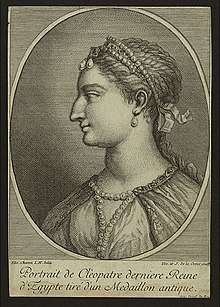
.jpg)
